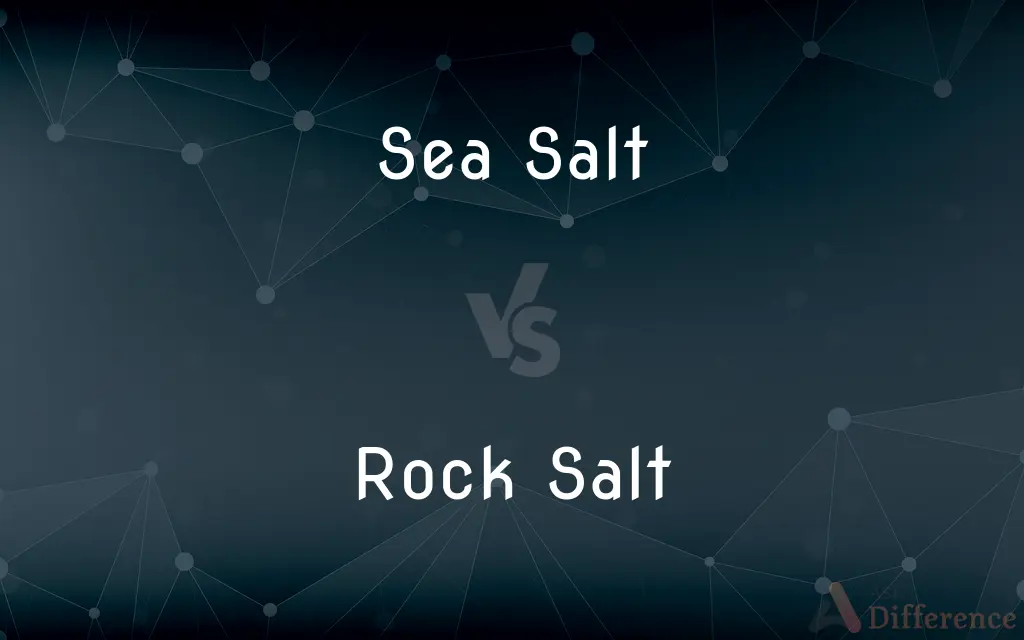Sea Salt vs. Rock Salt — What's the Difference?
By Tayyaba Rehman — Published on November 25, 2023
Sea Salt is obtained by evaporating seawater, while Rock Salt is mined from ancient underground salt deposits.

Difference Between Sea Salt and Rock Salt
Table of Contents
ADVERTISEMENT
Key Differences
Sea Salt and Rock Salt are two diverse types of salt used for various purposes. Sea Salt is sourced directly from the evaporation of seawater. It retains some trace minerals from the ocean, giving it a unique taste and texture. Conversely, Rock Salt is derived from ancient salt deposits found underground. As these deposits are remnants of evaporated seas from prehistoric times, Rock Salt is essentially aged Sea Salt. However, Rock Salt often contains impurities due to its underground origins, sometimes making it unsuitable for direct consumption.
In contrast, Sea Salt, with its minimal processing, retains its natural mineral content, contributing to its popularity in culinary applications.
Both salts play crucial roles in human history, with Sea Salt being a vital commodity in ancient trade and Rock Salt being used extensively in food preservation.
Comparison Chart
Source
Evaporation of seawater
Mined from underground deposits
Trace Minerals
Contains minerals like magnesium & potassium
May contain impurities and other minerals
ADVERTISEMENT
Taste & Texture
Unique taste due to trace minerals
Can be more neutral, often coarser in texture
Usage
Culinary purposes, therapeutic uses
De-icing, some culinary uses, industrial applications
Appearance
Can be flaky, varies in color
Typically opaque or translucent, often in larger crystals
Compare with Definitions
Sea Salt
Natural salt with minimal processing.
Sea Salt is lauded for its authentic and unaltered taste.
Rock Salt
Typically coarser than other salts.
The large crystals of Rock Salt make it effective for de-icing.
Sea Salt
Varies in color and grain size.
The pink hue in some Sea Salts is due to mineral content.
Rock Salt
May contain impurities and additional minerals.
It's essential to purify Rock Salt before culinary use.
Sea Salt
Often used in gourmet cooking.
The crunchy texture of Sea Salt enhances the dish's finish.
Rock Salt
Originates from prehistoric evaporated seas.
Over time, layers of sediment covered and preserved Rock Salt.
Sea Salt
Salt produced by evaporating seawater.
Many chefs prefer Sea Salt for its rich, natural flavor.
Rock Salt
Salt mined from ancient underground deposits.
Rock Salt is extensively used to melt ice on roads.
Sea Salt
Contains trace minerals from the ocean.
The magnesium in Sea Salt can offer health benefits.
Rock Salt
Used in industrial and some culinary applications.
Rock Salt lamps are popular for their aesthetic and purported health benefits.
Common Curiosities
Which salt is better for cooking, Sea Salt or Rock Salt?
Sea Salt is often preferred for cooking due to its flavor and trace minerals, but purified Rock Salt can also be used.
What is the primary source of Sea Salt?
Sea Salt is derived from the evaporation of seawater.
Why is Rock Salt often used on icy roads?
Rock Salt lowers the freezing point of water, causing ice to melt.
Is pink Himalayan salt a type of Rock Salt?
Yes, pink Himalayan salt is a variety of Rock Salt mined in the Himalayan region.
Are the minerals in Sea Salt beneficial?
Yes, Sea Salt contains beneficial trace minerals not found in refined table salt.
Does Rock Salt contain iodine like table salt?
Naturally, Rock Salt doesn't contain iodine, but it can be added during processing.
How is Rock Salt formed?
Rock Salt forms from ancient underground salt deposits left by prehistoric seas.
Can Rock Salt be used in a salt grinder?
Yes, but ensure it's food-grade Rock Salt and not the kind used for de-icing.
How does the taste of Sea Salt differ from Rock Salt?
Sea Salt often has a unique taste due to its trace minerals, while Rock Salt can have a more neutral flavor.
Why is Sea Salt often pricier than other salts?
The methods of harvesting and the presence of trace minerals can increase Sea Salt's price.
Share Your Discovery

Previous Comparison
Christmas Tree vs. Pine Tree
Next Comparison
Zeeman Effect vs. Stark EffectAuthor Spotlight
Written by
Tayyaba RehmanTayyaba Rehman is a distinguished writer, currently serving as a primary contributor to askdifference.com. As a researcher in semantics and etymology, Tayyaba's passion for the complexity of languages and their distinctions has found a perfect home on the platform. Tayyaba delves into the intricacies of language, distinguishing between commonly confused words and phrases, thereby providing clarity for readers worldwide.
















































